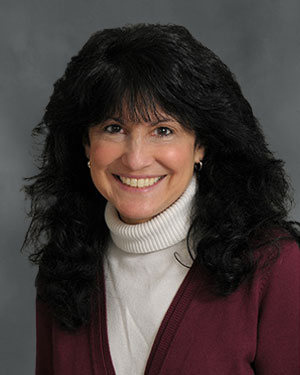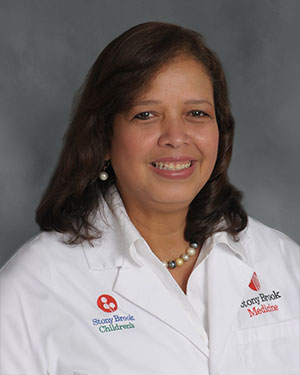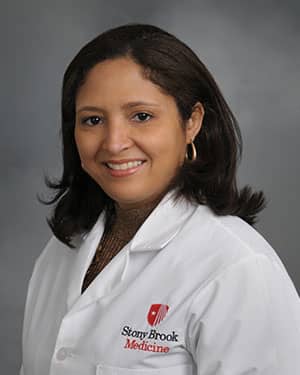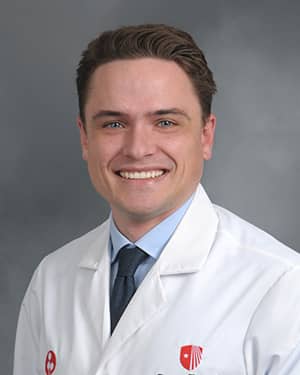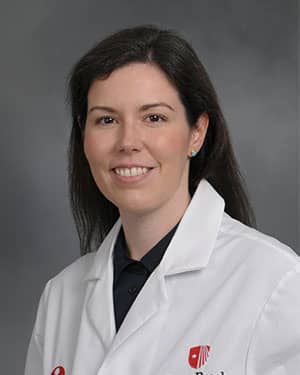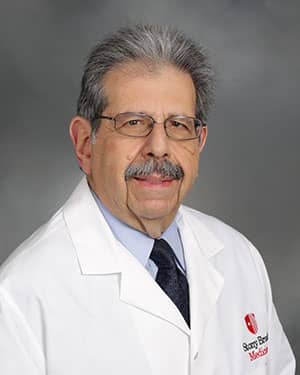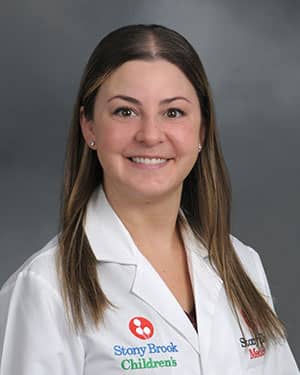Navigation Child Neurology
Child Neurology
Stony Brook Children's brings a breadth and depth of expertise to the care of children with neurological disorders. As Suffolk County's only Child Neurology program based in an academic medical institution, our team works on the front lines of medicine. We take on the region's most clinically complex cases, conduct vital research studies, and, as faculty of the Stony Brook University School of Medicine, teach tomorrow's neurologists.
Within Child Neurology, we have three specialty centers that provide comprehensive, multidisciplinary evaluation, treatment and long-term management of multiple sclerosis, epilepsy and Duchenne muscular dystrophy. Our Lourie Center for Pediatric Multiple Sclerosis is a designated Center of Excellence by the National Multiple Sclerosis Society. Our Duchenne Muscular Dystrophy Comprehensive Care Center is unparalleled in the region, and is modeled on standards of excellence established by the Centers for Disease Control and other national organizations.
Services
Part of the medical center's Program of Distinction in Neurosciences, our Child Neurology Division evaluates and treats patients ranging from newborns to young adults. We have the expertise, experience and technology to address the full gamut of neurological problems, including:
- Autism
- Brain tumors
- Cerebral palsy
- Developmental disorders
- Epilepsy and seizure disorders
- Genetic disorders
- Guillain Barré syndrome
- Hydrocephalus
- Infectious diseases
- Mental retardation
- Metabolic disorders
- Migraine headaches
- Motor development
- Movement disorders
- Multiple sclerosis
- Muscular dystrophy
- Tic disorders
- Vascular abnormalities
Stony Brook Comprehensive Epilepsy Center
Through the Stony Brook Comprehensive Epilepsy Center, we offer a uniquely focused approach to the diagnosis and treatment of children with seizure disorders. Our capabilities include:
- A five-bed dedicated video-EEG epilepsy monitoring unit (EMU) with 24/7 observation staff
- Portable video-EEG epilepsy monitoring capability that can be set up anywhere in the hospital where there is a patient experiencing possible seizures
- A multidisciplinary team, including renowned epileptologists, pediatric neurologists, neurosurgeons and neuropsychologist
- Multiple treatment options, including advanced surgical techniques
- Access to research, including clinical trials of new drugs and support and education services for patients and families
The Lourie Center for Pediatric MS
Established in 2002, The Lourie Center for Pediatric MS at Stony Brook Children's was the first multidisciplinary center dedicated to addressing the specific needs of pediatric multiple sclerosis patients in the United States. Today, it is one of six in the nation designated as a Center of Excellence by the National Multiple Sclerosis Society, which means it meets rigorous standards and offers an unparalleled depth and breadth of resources, including an international pediatric research program. Long Islanders are fortunate to have world-class care like this in their own community.
Our Team
Stony Brook Children's Child Neurology Division consists of a core team of pediatric neurologists. Working collaboratively with the hospital's full complement of pediatric and neurology subspecialists — including clinical neurophysiologists, epileptologists, neuroradiologists, neurosurgeons and neuro-oncologists — they provide diagnosis and management for a comprehensive range of disorders of the brain, spinal cord, muscles and nerves.
The Division is led by the renowned pediatric neurologist, epileptologist and clinical neurophysiologist, Mary Andriola, MD. Other team members include:
Pediatric Multiple Sclerosis Specialists
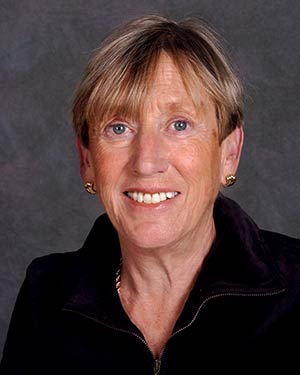
Locations
East Setauket Child Neurology
181 North Belle Mead RoadSuite 5 & 6
For appointments: (631) 444-2599
Commack Child Neurology
500 Commack Road, 2nd FloorCommack, NY 11725
For appointments: (631) 444-2599
Hampton Bays Child Neurology
225 W. Montauk HighwayHampton Bays, NY 11946
For appointments: (631) 444-2599
Smithtown Child Neurology
260 Middle Country Road, Suite 107Smithtown, NY 11787
For appointments: (631) 444-2599
Lourie Center for Pediatric Multiple Sclerosis
181 North Belle Mead Road, Suite 5 & 6East Setauket, NY 11733
Neurology Associates of Stony Brook
181 North Belle Meade RoadEast Setauket, NY 11733
Patient Resources
Below are several links to more information:
- Epilepsy Foundation of Long Island
- National Multiple Sclerosis Society
- Lourie Center for Pediatric MS
- Science News: Vitamin D Study
- American Epilepsy Foundation
Research and Education
At Stony Brook Medicine, research and education are key components of our mission. Our child neurology physicians are members of the faculty of the Stony Brook University School of Medicine and teach medical students, residents and fellows on an ongoing basis.
Multiple studies of anti-epileptic drugs and vagal nerve stimulation have been conducted over the years, and the staff presents and publishes their work extensively. Dr. Mary Andriola co-authored a volume on EEG that has been widely used in medical training. She has led or been a participating physician in dozens of clinical trials, and has authored and co-authored dozens of scientific papers and abstracts.
Dr. Andriola is Principal Investigator for two upcoming multicenter randomized double-blind, placebo-controlled trials to assess the safety and efficacy of pharmaceutical cannabidiol oral solution as an adjunctive therapy for treatment of subjects with inadequately controlled Lennox-Gastaut or Dravet syndromes. As a New York State-licensed medical doctor for medical marijuana, Dr. Andriola is currently treating patients with epilepsy requesting cannabidiol therapy and beginning a study of these patients.
Dr. Jill Miller-Horn is a peer reviewer for Clinical Pediatrics.
Definitions
Attention deficit disorder (ADD)/attention deficit with hyperactivity disorder (ADHD) may be characterized by difficulty with the following: paying attention, concentrating, following directions, learning, keeping still and completing tasks. Children with these disorders may be inclined to make impulsive decisions without stopping to think about the consequences of their choices. The disorder has three subtypes: inattentive, hyperactive-impulsive and combined.
This medical specialty studies the central and peripheral nervous systems through the recording of bioelectrical activity.
These disorders interfere with a child's development or acquisition of basic skills. There are many categories of developmental disorders. Specific developmental disorders affect a narrow area of development, such as a learning disability. Pervasive development disorders, such as autism, may affect a child's development overall. An example is the autism spectrum disorders, which affect a child's acquisition of communication and social skills, sensitivity to sensory stimulation and other areas. Children with developmental disorders vary widely in their abilities, intelligence and needs.
Electroencephalography (EEG) measures the activity of neurons in the brain using electrodes attached to the head. It is useful in diagnosing epilepsy, coma, encephalopathy and other brain disorders.
Recording electrical activity of the brain and nerves, such as with EEG, to diagnose illness and injuries.
A neurological disorder characterized by seizures.
An acute autoimmune disease of the peripheral nervous system. There are six types of GBS each with unique symptoms involving muscle weakness, paralysis and other symptoms.
A condition in which cerebrospinal fluid builds up in the ventricles, or cavities, of the brain. The head may swell, and intracranial pressure may build, resulting in headache, nausea, sleepiness, coma, brain damage or seizures.
Multiple sclerosis is a chronic, often disabling disease that attacks the central nervous system (CNS), which is made up of the brain, spinal cord and optic nerves. Symptoms may be mild, such as numbness in the limbs, or severe, such as paralysis or loss of vision.
The EEG in congenital malformations of cortical development, neurocutaneous disorders, cerebral palsy, autism/mental retardation and ADHD.
This medical subspecialty deals with cancers of the nervous system and spine.
This medical field focuses on the diagnosis and treatment of brain, spinal cord, vascular, and head and neck lesions or tumors using x-rays, magnetic fields, radio waves and ultrasound.

